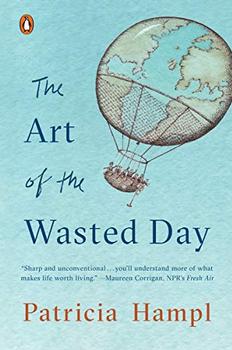Summary | Excerpt | Reading Guide | Reviews | Beyond the book | Read-Alikes | Genres & Themes | Author Bio

Critics' Opinion:
Readers' Opinion:
First Published:
Sep 2013, 144 pages
Paperback:
Jul 2014, 144 pages
 Book Reviewed by:
Book Reviewed by:
Elena Spagnolie
Buy This Book
In Levels of Life, Julian Barnes, winner of the 2011 Man Booker Prize for The Sense of an Ending, describes the intense loss and disorientation he feels since his wife, renowned literary agent Pat Kavanagh, died from a brain tumor only 37 days after being diagnosed in the fall of 2008.  This slim book, which is divided into three sections, "The Sin of Height," "On the Level," and "The Loss of Depth," begins much like you might expect from Barnes. He uses careful research of an interesting and quirky subject in history – in this case, hot air ballooning in the 19th century – and with a combination of refined coolness and subtle ironic humor, looks thoughtfully at the lives, innovations, and personal ballooning interactions of a selection of characters: French actress Sarah Bernhardt; soldier and adventurer, Colonel Fred Burnaby; groundbreaking artist/photographer Félix Tournachon (aka Nadar). And as the invention of ballooning literally gave people a new perspective on the world, our understanding of God, ourselves, and what is possible changed too:
This slim book, which is divided into three sections, "The Sin of Height," "On the Level," and "The Loss of Depth," begins much like you might expect from Barnes. He uses careful research of an interesting and quirky subject in history – in this case, hot air ballooning in the 19th century – and with a combination of refined coolness and subtle ironic humor, looks thoughtfully at the lives, innovations, and personal ballooning interactions of a selection of characters: French actress Sarah Bernhardt; soldier and adventurer, Colonel Fred Burnaby; groundbreaking artist/photographer Félix Tournachon (aka Nadar). And as the invention of ballooning literally gave people a new perspective on the world, our understanding of God, ourselves, and what is possible changed too:
Once, the peasant had looked up at the heavens, where God lived, fearing thunder, hail, and God's anger, hoping for sun, a rainbow, and God's approval. Now, the modern peasant looked up at the heavens and saw instead the less daunting arrival of Colonel Fred Burnaby, cigar in one pocket and half-sovereign in the other…
 So it is with love. Barnes creates a metaphor between love (found and lost) and the intrepid adventure of hot-air ballooning and lays the groundwork for talking about the death of his wife. Initially, the connection feels somewhat unnatural; however Barnes's thoughtful writing and rich illustrative comparisons carry it through:
So it is with love. Barnes creates a metaphor between love (found and lost) and the intrepid adventure of hot-air ballooning and lays the groundwork for talking about the death of his wife. Initially, the connection feels somewhat unnatural; however Barnes's thoughtful writing and rich illustrative comparisons carry it through:
You put together two people who have not been put together before. Sometimes it is like that first attempt to harness a hydrogen balloon to a fire balloon: do you prefer crash and burn, or burn and crash? But sometimes it works, and something new is made, and the world is changed. Then, at some point, sooner or later, for this reason or that, one of them is taken away. And what is taken away is greater than the sum of what was there. This may not be mathematically possible; but it is emotionally possible.
While his exploration of ballooning and 19th century figures is interesting enough and successfully helps him depict his profound loss later in the book, I often found myself wondering, "Where's he going with this?" or "Why am I reading this?" The second half of the book is so much more personal and important, it makes this cerebral history seem unnecessary and almost off topic. The real meat of the story is in Barnes's musings on death and his experience trying to cope without his beloved partner.
He doesn't spend much time describing her life or detailing the circumstances of her illness – in fact he doesn't even mention her name. Instead he focuses on her absence, his inability to feel consoled by friends, his contemplation of suicide:
The question of suicide arrives early, and quite logically. …I knew soon enough my preferred method – a hot bath, a glass of wine next to the taps, and an exceptionally sharp Japanese carving knife. …It took a while, but I remember the moment – or rather, the suddenly arriving argument – which made it less likely that I would kill myself. I realized that, insofar as she was alive at all, she was alive in my memory. …I was her principal rememberer.
Barnes's writing is spare and straightforward and in easily digestible, yet wandering paragraphs he explores philosophical questions on a very personal level: "What is 'success' in mourning?' Does it lie in remembering or in forgetting?" Some of his conclusions hint at his anger and even his arrogance, but his writing is always intelligent, intimate, and incredibly engaging. Even if the first two sections of the book seem a bit superfluous and cerebral, the third section makes it a recommendable and very worthwhile read.
First image of Pat Kavanagh and Julian Barnes by Jillian Edelstein/Camera Press
Second image of hot air balloon from Wikipedia
![]() This review was originally published in The BookBrowse Review in October 2013, and has been updated for the
July 2014 edition.
Click here to go to this issue.
This review was originally published in The BookBrowse Review in October 2013, and has been updated for the
July 2014 edition.
Click here to go to this issue.

If you liked Levels of Life, try these:

by Allison Pataki
Published 2019
A deeply moving memoir about a young couple whose lives were changed in the blink of an eye, and the love that helped them rewrite their future.

by Patricia Hampl
Published 2019
A spirited inquiry into the lost value of leisure and daydream.





The House on Biscayne Bay
by Chanel Cleeton
As death stalks a gothic mansion in Miami, the lives of two women intertwine as the past and present collide.

The Flower Sisters
by Michelle Collins Anderson
From the new Fannie Flagg of the Ozarks, a richly-woven story of family, forgiveness, and reinvention.

The Funeral Cryer by Wenyan Lu
Debut novelist Wenyan Lu brings us this witty yet profound story about one woman's midlife reawakening in contemporary rural China.
Your guide toexceptional books
BookBrowse seeks out and recommends the best in contemporary fiction and nonfiction—books that not only engage and entertain but also deepen our understanding of ourselves and the world around us.